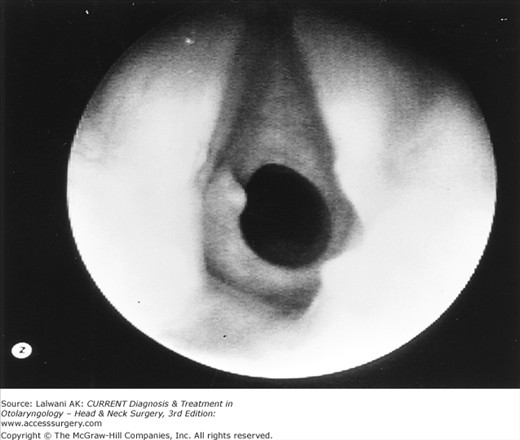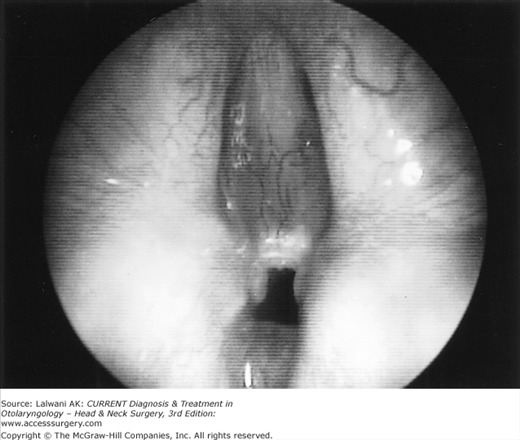Essentials of Diagnosis
General Considerations
Advances in care of premature infants in the last few decades have resulted in increased survival rates and a new population of patients with a history of prolonged intubation. A proportion of these patients develop subglottic stenosis up to 8%, according to some reports. Further advances in endotracheal tube and ventilation management in the last 30 y have decreased the incidence of subglottic stenosis in the neonatal population to <1%. A second population of infants born with congenital subglottic stenosis has remained stable at approximately 5%. These patients provide some of the greatest diagnostic and management challenges for the otolaryngologist.
Other airway abnormalities—both congenital and iatrogenic—including laryngomalacia, vocal fold paralysis, and supraglottic and glottic stenosis, have prompted otolaryngologists to continue to refine surgical airway reconstruction techniques. These techniques are becoming further advanced with the advent of endoscopic minimally invasive surgical procedures including robotic assisted endoscopic airway reconstruction on the horizon.
Pathogenesis
The incidence of congenital subglottic stenosis is approximately 5%. The cricoid cartilage develops abnormally and may be elliptical or flattened in shape, causing cartilaginous stenosis. The remainder of subglottic stenosis is considered to be iatrogenic—airway intubation with large tube size relative to airway diameter and duration of intubation both playing roles. Host factors also play a significant role, however, because some children intubated for a very short time develop subglottic stenosis, whereas others with a prolonged intubation history do not.
Acquired subglottic stenosis more often involves soft tissue stenosis in contrast to the congenital form, which results in cartilaginous stenosis. Pressure is considered to play a role, causing initial mucosal edema and inflammation with subsequent ulceration and finally fibrosis (Figure 40–1). Other factors may exacerbate stenosis development such as gastroesophageal reflux disease (GERD) and infection. The characterization of stenosis during diagnostic endoscopy, including the location, severity, and length of the stenosis, is extremely important and helps to direct management options and predict outcomes.
Laryngomalacia is the most common cause of neonatal stridor (54–75%). The disorder is characterized by reduced laryngeal tone, shortened aryepiglottic folds, and supraglottic collapse causing prolapse of structures into the airway on inspiration. Laryngomalacia is classified into three main types based on the anatomic portion of the supraglottic structures that is prolapsing, although any combination can coexist.
Two main theories of etiology exist. The first proposes that immature cartilage lacks the stiff structure of more mature cartilage. The second theory suggests immature neural innervation, which is a form of hypotonia. Laryngomalacia can be exacerbated by other entities such as GERD, with a coincidence of up to 80%.
Vocal fold paralysis is the second most common cause of stridor in neonates after laryngomalacia, accounting for 10% of congenital lesions of the larynx. This condition may be congenital or secondary to an abnormality along the course of the recurrent laryngeal nerve. Vocal fold paralysis is bilateral in up to 30–62% of cases. The most common etiology is secondary to hydrocephalus from a malformation such as Arnold-Chiari. Protrusion of intracerebral contents through the jugular foramen causes stretching of the vagus nerve. Intubation and birth trauma can lead to compression or stretching of both recurrent laryngeal nerves in the neonate. Iatrogenic causes of vocal fold paralysis include cardiovascular surgery and repair of tracheoesophageal fistulas. Once the primary cause has been addressed, the paralysis should resolve. For idiopathic vocal fold paralysis, surgical intervention may be required.
Glottic stenosis is generally iatrogenic, resulting from either traumatic intubation involving a similar pathogenesis as subglottic stenosis or prior laser procedures on the airway such as CO2 laser excision of a papilloma. The etiology of supraglottic stenosis may also involve prior airway laser surgery or previous open airway procedures involving long-term indwelling stents with subsequent granulation tissue and fibrosis formation. GERD may also play a role in both of these diagnoses.
Laryngeal webs can be either congenital or acquired secondary to prior airway procedures, intubation, or infection (Figure 40–2). Congenital laryngeal webs are rare malformations in which abnormal fibrous tissue is formed between two intrinsic structures of the larynx. Congenital webs are considered a form of laryngeal stenosis or atresia and warrant further evaluation for other congenital conditions. The pathogenesis of acquired laryngeal web generally involves development of an inflammatory process in reaction to the initial insult, with subsequent maturation and scar formation.
Laryngeal clefts are defects in the larynx that arise from the failure of fusion and/or incomplete development of the tracheoesophageal septum. They can be classified based on extent. Type I clefts are defects in the supraglottic interarytenoid region that extends no further than the level of the true vocal folds. Type II clefts extend below the level of the true vocal folds. Type III clefts involve a complete defect of the cricoid cartilage, and type IV clefts extend into the posterior wall of the thoracic trachea.
Prevention
Advances in airway management of the premature infant over the last 30 y have brought incidence rates of subglottic stenosis from 8% down to <1%. Low-irritant endotracheal tubes, nasal endotracheal intubation, and appropriately sized endotracheal tubes can reduce the risk of developing subsequent airway stenosis. Awareness of the dangers of aggressive laser use in the airway has also contributed to decreased rates of iatrogenic airway lesions such as glottic stenosis and laryngeal web formation.
Clinical Findings
Stridor is one of the foremost features of airway pathology. A more typical presentation of acquired subglottic stenosis, however, may be of a premature infant with a history of intubation that failed on several attempts at extubation in the intensive care unit. For an older child with an initially less-severe airway lesion, voice changes, feeding difficulties, or progressive respiratory symptoms may develop.
Posteroanterior neck and chest x-rays can be helpful in diagnosing some airway lesions. Airway fluoroscopy may demonstrate coexisting pathology, such as tracheomalacia, but is dependent on the expertise of the radiologist for the diagnosis. Preoperative barium swallow is recommended if a child has a history of feeding difficulties. Computed tomography scanning or magnetic resonance imaging can provide information on both the severity and the length of the stenoses, but should never replace endoscopic evaluation. Imaging studies may also be helpful in diagnosing tracheal compression secondary to a vascular lesion.
The association between airway pathology and GERD has been documented. Most airway surgeons currently recommend a preoperative evaluation for GERD for patients undergoing open airway procedures. The study of choice for diagnosis is a dual-channel pH probe. This test involves a probe in the pharynx (above the upper esophageal sphincter) and in the esophagus (above the lower esophageal sphincter) for detection of acid over a 24-h period. If GERD is found, medical therapy for 3 mo is recommended before considering airway surgery. If a repeat pH probe is still found to be positive, antireflux surgery is recommended before considering airway surgery.
Stay updated, free articles. Join our Telegram channel

Full access? Get Clinical Tree




